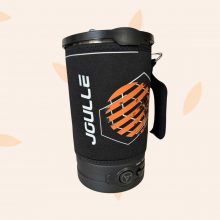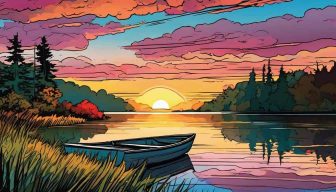- A guide to building an eco-friendly camping bed
- Benefits of eco-friendly camping
- Building the bed, piece by piece
- Sleeping Pad
- Sleeping Bag
- Camping Cot
- Camping Pillow
- Sustainable sheets
- Eco-friendly blankets and quilts
- Trusted Brands for eco-friendly camping beds
- Eco-friendly camping bed materials
- Chemicals to Avoid in Camping Gear
- Low-Impact Manufacturing
- Recycling and Repurposing
- Sustainability Certifications
- Eco-Camping Resources
- FAQs
- Final Thoughts
- Portable Power Station Guides
- Backpacking & Camping Guides
- Non-Toxic Tent Reviews
- Vegan Product Reviews
- Outdoor Gear Reviews
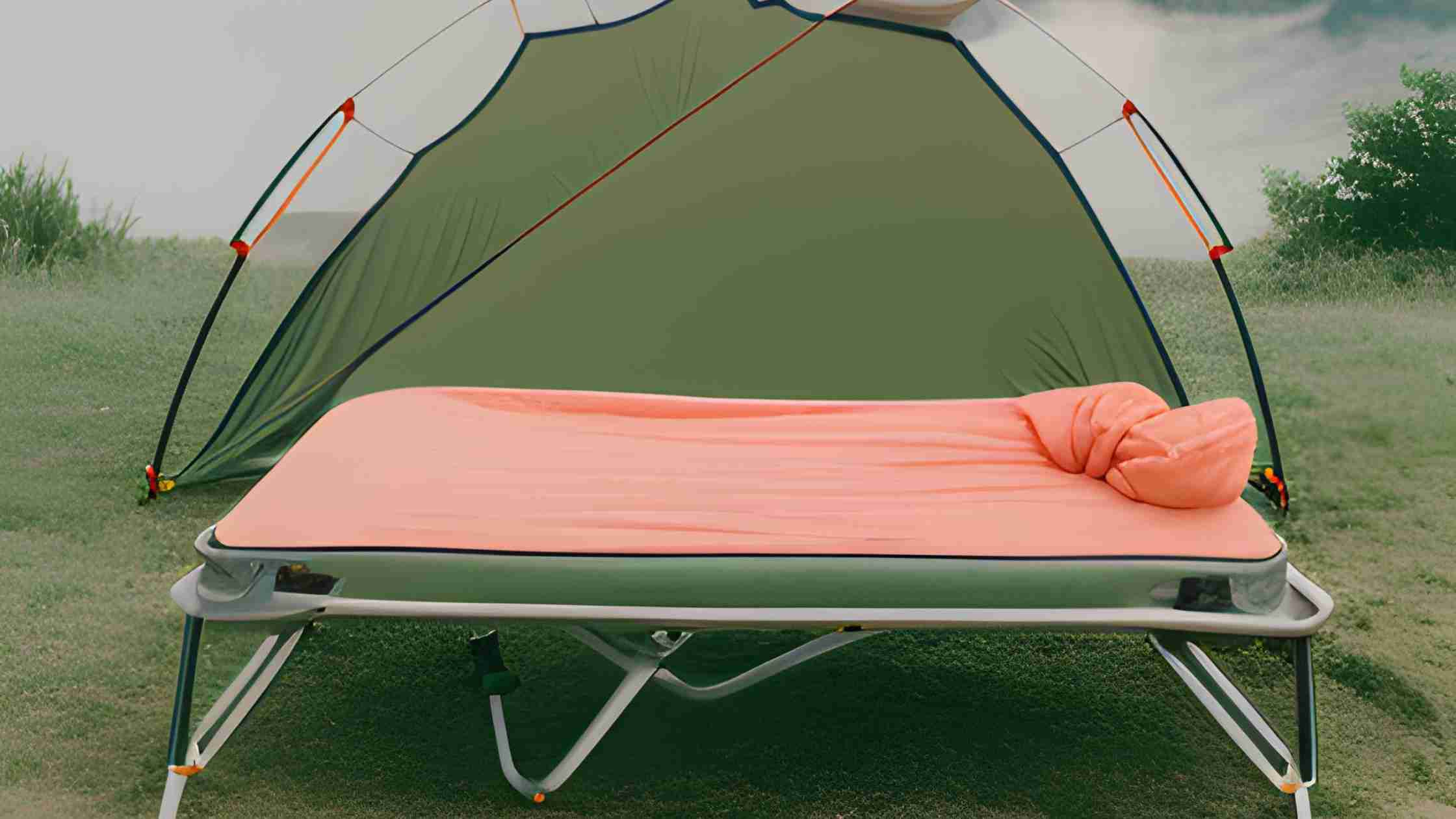
A guide to building an eco-friendly camping bed
Do you want to take your camping game to the next level and reduce your environmental footprint? One way to do this is by investing in an eco-friendly camping bed. In this article we’re going to cover the benefits of a sustainable camping bed, key elements of their construction and design, and some of the best options available.
Benefits of eco-friendly camping
An eco-friendly camping bed has several benefits that make it a great investment:
Better for the environment: Environmentally friendly camping gear is often made from sustainable or renewable materials, which are more biodegradable and less damaging to the environment.
Better for your health: Eco-friendly camping gear is made from natural or sustainable materials, which are less likely to contain harmful chemicals and toxins. Conventional camping gear often contains synthetics that are linked to health issues like hormone disruption or birth defects. Some eco-friendly gear also have antimicrobial covers and anti-mite fabrics to prevent allergens or bacteria.
Long lasting and durable: Eco-friendly camping gear are often made with sturdy, lightweight materials like bamboo, hemp and recycled polyester and are designed to be weather resistant, rip-proof and able withstand use in harsh outdoor environments.
Building the bed, piece by piece
While there is no “right” way to create such a setup, there are basic components that will make sure your outdoor slumbers are as cozy as possible:
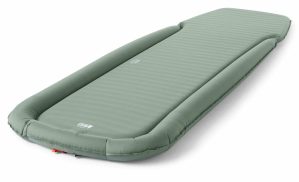
Sleeping Pad
A sleeping pad provides insulation and cushion on top of or below your sleeping bag. There two main types of pads – foam or air-filled. Air filled camping pads are considered to be more eco-friendly because they produce less waste.

NEMO Roamer Sleeping Pad
| Preview | Product | Rating | Price | |
|---|---|---|---|---|
| | NEMO Roamer Sleeping Pad, XL Wide | No ratings yet | $249.95 | Buy on Amazon |
- Pad Thickness: 4 in
- Weight: 5.5 lbs
- Sleeping Pad Type: Air (Self-Inflating)
- Insulation Type: Open-cell Foam
- R-Value: 6
- Dimensions: 78 x 30 x 4 in
- Sustainability: Made from bluesign®-certified 100% post-consumer recycled materials
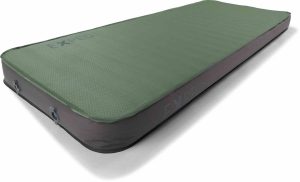
Exped MegaMat Sleeping Pad
| Preview | Product | Rating | Price | |
|---|---|---|---|---|
| | Exped MegaMat 10 | Self-Inflating Camping Mat | Extremely Comfortable & Luxurious Sleeping Pad,… | No ratings yet | $239.95 | Buy on Amazon |
- Pad Thickness: 4 in
- Weight: 4.9 lbs
- Sleeping Pad Type: Air (Self-Inflatable)
- Insulation Type: Open-cell Foam
- R-Value: 8.1
- Temperature Limit: -40 °F
- Dimensions: 72.1 x 25.6 x 4 in
- Sustainability: Certified climate neutral through myclimate
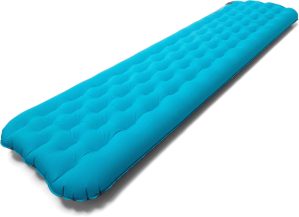
Big Agnes Insulated Q-Core Deluxe Sleeping Pad
| Preview | Product | Rating | Price | |
|---|---|---|---|---|
| | Big Agnes Insulated Q-Core Deluxe Sleeping Pad, 20×72 (Regular) | No ratings yet | $169.95 | Buy on Amazon |
- Pad Thickness: 3.5 in
- Weight: 1.56 lbs
- Sleeping Pad Type: Air
- Insulation Type: Synthetic
- R-Value: 4.3
- Seasons: 3
- Dimensions: 72 x 20 x 3.5 inches
- Sustainability: Pad inflation sack made from up-cycled excess pad material
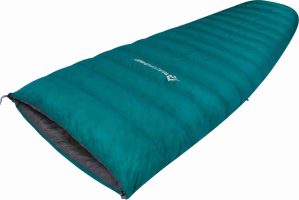
Sleeping Bag
A sustainable sleeping bag provides different levels of warmth depending on the season you plan camping. The materials below are the most eco-friendly options for sleeping bag materials:
- Organic cotton
- Recycled materials
- Certified Responsibly Sourced Down (comes from ducks or geese that were not force-fed or live-plucked)
- Certified Responsibly Sourced Wool
- Organic hemp
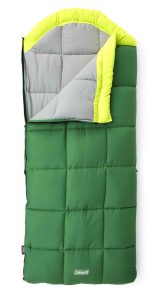
Coleman Arch Bay 30 Sleeping Bag
- Fill: Ecotherm
- Weight: 3 lbs. 11.2 oz.
- Temperature Rating: 30 degrees (F)
- Fits Up To: 81 inches
- Sustainability: Shell, liner and fill made with 100% recycled polyester

REI Co-op Trailmade 20 Sleeping Bag
- Fill: Recycled polyester
- Weight: 3 lbs 4.6 oz
- Temperature Rating: 21 degrees (F)
- Fits Up To: 72 in
- Sustainability: Shell made with recycled polyester
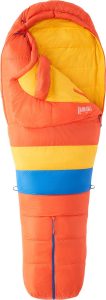
Marmot Always Summer Sleeping Bag
- Fill: Recycled polyester
- Weight: 1 lb. 12.6 oz.
- Temperature Rating: 40 degrees (F)
- Fits Up To: 72 in
- Sustainability: Recycled ripstop nylon and nylon taffeta
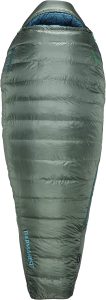
Therm-a-Rest Questar 0F/-18C Sleeping Bag
| Preview | Product | Rating | Price | |
|---|---|---|---|---|
| | Therm-a-Rest Questar 0F/-18C Lightweight Down Mummy Sleeping Bag, Balsam | No ratings yet | $439.95 | Buy on Amazon |
- Fill: 650 Fill Duck Nikwax Hydrophobic Down RDS
- Weight: 1 lbs 10 oz (Small), 1 lbs 13 oz (Regular)
- Temperature Rating: 0F/-18C
- Fits Up To: 80 in (regular)
- Sustainability: The down filling absorbs 90% less water and dries 3 times faster without using dangerous PFCs. Therm-a-Rest also actively works to ensure that the down used their products is sourced with the least harm possible to animals. Their product development team plays an active role in the Outdoor Industry Association (OIA) and its Textile Exchange Materials Traceability Working Group (TEMTWG).

Camping Cot
A camping cot is a portable bed typically made from lightweight materials, with a sturdy, elevated frame that enables you to sleep above the ground. This is usually more comfortable than just lying on a sleeping pad because your body temperature is regulated more efficiently, and your body is kept away from bugs and dirt.
Camping Pillow
The type of pillow you select will depend on personal preference. Some people prefer inflatable pillows while others prefer pillows filled with insulation. Eco-friendly camping pillows are made from the following:
- Organic cotton
- Recycled materials
- Bamboo
- Kapok
- Buckwheat hulls
Sustainable sheets
A perfect camping bed requires sustainable sheets. Look for bed sheets made from bamboo, organic cotton or hemp fibers which are either unbleached or low impact dyed – this ensures fewer chemicals or nasty additives.
Environmentally friendly fabrics are not only softer to sleep on, but they can help conserve agricultural resources such as water management, pest control, local biodiversity and soil health.
Eco-friendly blankets and quilts
Choose blankets and quilts made from natural materials like responsibly sourced wool or organic cotton. If you need more warmth or water resistance, select a synthetic down blanket made from recycled polyester made from plastic bottle recycling programs – this helps reduce landfill waste!
Trusted Brands for eco-friendly camping beds
Eco-friendly camping bed materials
Organic cotton
Organic cotton is grown without chemical fertilizers and pesticides, making it cleaner and better for the environment than regular cotton.
Hemp
Hemp has also been steadily growing in popularity due to its hypoallergenic qualities, durable construction, and beneficial environmental impact. It needs minimal water resources to grow and doesn’t require chemical treatments during production.
Bamboo
Bamboo offers many of the same benefits as hemp but is softer to the touch; additionally, bamboo can help regulate body temperature so you stay cool (or warm) depending on the season when you wear it – great news if you live in climates with extreme weather changes year-round.
BioTex Polypropylene
BioTex Polypropylene* is a cruelty-free vegan canvas made from plant fibers that is also mold and mildew resistant.
Recycled polyester fabric
Recycled polyester is made from discarded plastic bottles that are melted down and spun into fibers. These fibers can be found in many camping items, such as tents and sleeping bags. What’s more, Polyester is water resistant, lightweight and breathable.
Recycled foam mattress
When it comes to mattresses, the phrase “recycled foam” may evoke feelings of settling for less. However, thanks to modern technologies, that couldn’t be further from the truth. Recycled foams are made using ground up scrap material from other sources (such as mattresses or chairs) which are then melted down and turned into usable foam again. This process helps us close the environmental lifecycle loop and reduce our reliance on petrochemicals.
Natural latex mattress
Natural latex resists dust mites and mold which can cause allergic reactions and illnesses. It also naturally dissipates heat quickly which makes it cool to sleep on during those hot summer months. Its supportive structure, superior breathability and rapid biodegradation properties make it ideally suited for the outdoors.
Kapok fibers
If you’re not familiar with kapok fiber, it is a silky fiber that has been used in mattresses and pillows since as far back as the 18th century. Kapok fibers are harvested from trees found in tropical forests around the world.
Kapok fibers are hypoallergenic and resistant to dust mites, while also being lightweight and compact—making them perfect for taking out into the wilderness. I’m especially impressed with how durable these fibers are: they stabilize temperatures better than other types of bedding making them great for both hot and cold climates
Chemicals to Avoid in Camping Gear
If you’re looking for ways to reduce your toxic exposure while enjoying nature, here are some of the top chemicals to avoid when choosing an eco-friendly camping bed:
Flame Retardants
Flame retardants contain persistent, bioaccumulative toxins (PBTs) that can cause cancer and damage the immune system. Choose camping beds that are labeled “no added flame retardant chemicals” or “fire safe” certified by organizations like Oeko-Tex or GreenGuard.
Phthalates
Phthalates are plasticizing compounds used to soften PVC materials commonly used in camp beds. Long term exposure to these chemicals has been linked to endocrine disruption, reduced sperm count, birth defects, and reproductive problems. Choose camping beds made from materials such as organic cotton canvas or wool batting instead of synthetic fibers like polyester filled with foam-like products made of synthetic materials.
Polybrominated Diphenyl Ethers (PBDEs)
PBDEs are a group of flame-retardant chemicals that were banned in Europe and the United States due to their potential health hazards. These compounds can leach into the environment causing hormonal system disruption, reproductive damage and other health impacts. To avoid these toxins when selecting eco-friendly camping beds, look for products labeled as “no added PBDEs”.
Low-Impact Manufacturing
Eco-friendly camping beds are constructed using low-impact manufacturing processes designed to minimize waste and reduce energy consumption.
For example, some manufacturers use solar or wind power to run their factories, and others implement closed-loop systems that recycle water and other resources. By reducing the environmental impact of the manufacturing process, eco-friendly camping beds can help to protect natural resources and reduce pollution.
Recycling and Repurposing
Finally, eco-friendly camping beds should be easy to recycle or repurpose at the end of their life cycle. Many manufacturers design their beds with this in mind, using materials that can be easily broken down and reused.
For example, some camping beds are made with components that can be disassembled and recycled separately. I recently had the pleasure of experiencing just how easy it is to recycle a part of my camping bed. After a few days in nature, my friends and I disassembled our air pad bed quite quickly.
We divided up the pieces neatly by separating out the parts made from different materials – waterproof outer fabrics, foam insulations and more – before leaving with our designated recyclable pieces in hand. I brought my pieces to a local manufacturing facility, and viola my eco-friendly camping bed gets to be reincarnated and something new.
You can also repurpose parts of your camping setup, for example you can use the fabric from your tent to make a few other items, such as blankets and pillowcases.
Sustainability Certifications
Bluesign Certification: Ensures that products have been manufactured using sustainable and eco-friendly materials and processes.
Global Organic Textile Standard (GOTS): Ensures that products are sourced from certified organic farms that grow crops without the use of chemicals, genetically modified organisms, synthetic fertilizers or pesticides. On top of that, these crops must follow strict social criteria aimed at creating a safe working environment for all employees.
OEKO-TEX Standard 100: Verifies that textiles have been tested for harmful substances according to strict evaluation criteria. It also requires manufacturers to undergo regular testing and quality assurance audits. The standard goes beyond traditional health requirements and considers ecological aspects such as bioaccumulation potential.
Cradle to Cradle Certified: Focuses on design to ensure that products can be recycled or repurposed at the end of their life cycle. This system works to eliminate waste and pollution by properly managing materials throughout their life cycle.
Forest Stewardship Council (FSC): Ensures wood-based products are sourced from forests that practice responsible forest management. Logging operations must meet strict environmental and social standards while protecting sensitive environments (such as wetlands) and respecting local communities’ cultural customs.
Responsible Down Standard: RDS is an independent, voluntary global standard that tracks down from cradle to gate. It aims to ensure that down and feathers come from humanely-treated animals and meets animal welfare standards throughout their life cycle. The RDS sets out material requirements for the traceability of down, humane living conditions for the birds, and non-force feeding practices.
Responsible Wool Standard: RWS is a global initiative that sets strong animal welfare and environmental standards across the entire production process responsible wool production. It covers pasture management practices, animal health & husbandry, sheep shearing and labor on farm as well as fiber processing/manufacturing facilities in order to promote responsible wool production.
Eco-Camping Resources
- Leave No Trace: https://lnt.org/
- Outdoor Industry Association: https://outdoorindustry.org/
- The Wilderness Society: https://www.wilderness.org/
- “Kamp Green” by KOA
- “Eco Camping: Your Friendly Guide” by The Gone Goat
- “Eco-Friendly Camping Tips and Products” by Grove Co.
- “Eco-Friendly Camping Gear: Sustainable Camping Checklist” by Brainy Backpackers
- “10 Tips for Eco-Friendly Camping” by The Dyrt
- “Eco-Camping: 9 Tips for a More Sustainable Campsite” by Hipcamp
- “Eco-Camping: Leave No Trace, Take Only Memories” by The National Wildlife Federation
FAQs
How can I be environmentally friendly while camping?
Camping is an excellent way to experience nature and help preserve it! To be as eco-friendly while camping, try to follow the principles of Leave No Trace; this means leaving your campsite free of garbage, reducing the use of resources like firewood and water, and minimizing your environmental impact. Ensuring that you have the necessary items for sustainable camping such as compostable trash bags, reusable containers, food scraps for composting, and a solar-powered flashlight may also go a long way.
What is the most comfortable thing to sleep on when camping?
For ultimate comfort while campsite sleeping, nothing beats a raised camp bed. Not only are they significantly more comfortable than sleeping directly on the ground, but they also provide extra insulation and warmth.
Is a sleeping mat or air bed better for camping?
This really depends on your preferences and physical requirements. A sleeping mat is generally lightweight and easy to transport, while an air bed may be more comfortable but can also be bulky and is not as easy to carry around.
What materials are used to make eco-friendly camping beds?
Sustainable materials used to make eco-friendly camping beds include organic cotton, hemp, bamboo, and wool. These materials help reduce the carbon footprint of your camping bed for a more environmentally-friendly experience.
How do I know if a material is truly sustainable?
To determine if a material is truly sustainable, you should research both the manufacturing process and the type of fibers used in production. Look for certifications such as OEKO-TEX Standard 100 or Fairtrade verified which guarantee high quality standards have been adhered to during production.
Final Thoughts
Going green when you go camping can make a huge environmental difference. With the right materials, you can build your own eco–friendly camping bed. This guide has outlined some of the benefits of making a DIY bed, as well as suggested resources to use while you put together yours. Whether used in your RV or in your tent, an eco–friendly camping bed will not only be more comfortable than an air mattress but also reduce our collective carbon footprint.
Fair Trade Finder makes product and service recommendations, based on thorough research and comparison analysis. Read more.
Portable Power Station Guides
- How to Choose a Portable Power Station for Home Use; A Comprehensive Guide
- Portable Power Station Maintenance Guide: Tips & Tricks
- Portable Power Station Outlet Guide & Compatibility
- EcoFlow vs Jackery: Which Portable Power Station Is Best for You?
- Jackery Vs Goal Zero: Which Eco-Friendly Power Source Is Right For You?
Backpacking & Camping Guides
- The Ultimate Guide to Backpacking
- Best Backpacking Trails in the US
- The Best California Backpacking Trips for Adventure Junkies
- The Best Campsites in Washington
- The Best Yosemite Backpacking Trails
Non-Toxic Tent Reviews
- Non-Toxic Camping Tents
- The Best Non Toxic Tents Without Flame Retardants Harmful to Human Health
- Exploring Non-Toxic Tent Materials for Health-Conscious Campers
- How are Tents Made? A Step-by-Step Guide
Vegan Product Reviews
- 20+ of the Best Vegan Sneaker Brands
- The Best Vegan Sandals Brands
- Sustainable Hiking Shoes Made From Recycled Materials
- How to Choose the Perfect Vegan Hiking Boot
- How to Clean Hemp Shoes: A Comprehensive Guide for Sustainable Footwear





